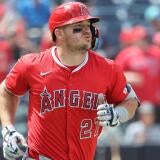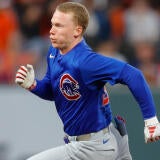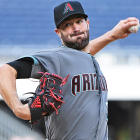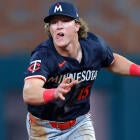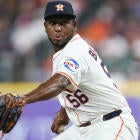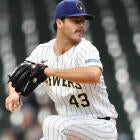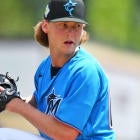Robbie Ray was a tough pitcher to figure out last season.
His 4.90 ERA indicated he was barely worth a Fantasy owner's time, while his peripherals suggested a much better pitcher lurked beneath the surface, waiting to be unleashed. Ray was among the league leaders in strikeout rate, fanning a whopping 28.1 percent of opposing batters. If you knew nothing else about him, that would be enough to get excited over.
He struggled to keep the ball in the yard, allowing 1.24 HR/9, and had trouble with runners on base, posting a middling 68.7 percent strand rate. Both issues can be the result of some bad luck, but some pitchers also simply struggle with runners on base or with limiting weak contact. It was fair to wonder if that was the case for Ray.
At least so far, he has solved both issues, lowering his HR/9 to 0.91 while raising his strand rate to 79.2 percent, both very respectable rates. With a 3.00 ERA through his first 11 starts – along with a strong WHIP and that still-elite strikeout rate – are we finally seeing Ray figure things out?
If we are, the results are mighty impressive. He hasn't allowed a run in his last three starts, giving him 23 2/3 scoreless innings in that span. He has struck out 25 and walked just three, while allowing not even a single ball over the fence. No homers, few walks, and suddenly, Ray looks like an absolute stud. Even if he can't keep that kind of production up, his season-long numbers still have him as a top-12 starting pitcher in both H2H points and Rotisserie scoring formats. For someone pegged as a popular breakout candidate before the season, it's easy to buy in. Is there any reason to expect another shoe to drop at some point?
This wouldn't be a very long column if the answer was just a flat no, would it? Ray is pitching incredibly well right now, but he isn't a fundamentally different pitcher than he has been in the past, despite the presence of some very real changes. With Ray, we can identify three key hurdles he needed to clear to make a true leap coming into the season, and assess whether he has done so. He needed to improve these three things -- his platoon splits, his pitching at home and his ability to induce weak contact. Let's grade him.
Platoon splits: B-
Ray is definitely pitching better against right-handed batters than ever before, sporting a .619 OPS against them thus far, vs. a .765 career mark. When you look under the hood a bit, however, much of his improvements vanish:
Ray is getting more strikeouts, but his control against RHB is still iffy, and much of his apparent improvement is tied to a BABIP nearly 90 points lower than his career mark. The addition of a curveball might help neutralize some of the platoon advantage for RHB – he has yet to allow an extra-base hit with the pitch to a righty – but it's still too early to say definitively. Once that BABIP against righties normalizes, where does Ray end up?
Home/Road splits: F
Ray has simply never pitched well at home. In 185 career innings at Chase Field, he has a 5.59 ERA, vs. a 3.31 mark on the road. And, that incredible three-start stretch Ray is on? All on the road, where he has allowed just three earned runs in 42 1/3 innings.
At Chase, it's been more of the same, with a 6.75 ERA and 2.0 HR/9. Chase is an unforgiving place to call home for a pitcher, and Ray isn't likely to get traded, so this might not be a place where you can expect much improvement.
Except, maybe there is. The Diamondbacks are installing a humidor at Chase Field, which is expected to be in place by July. Balls will then be stored there for two weeks before being put in play, according to MLB.com, which means we could see a change in the offensive environment as soon as after the All-Star break. It's hard to say exactly what the effects might be beforehand, but a study done by Alan Nathan, a professor of physics at the University of Illinois, estimated we could see a 50 percent reduction in homers at Chase, according to the Arizona Republic.
Given Ray's flyball proclivity, that could lead to a substantial change in his value. This is one place where Ray could see improvement through factors entirely beyond his control, and that could send his value soaring, even if the actual effects are just half of what Nathan proposes.
Contact quality: D-
This is where it's hard to see Ray as some improved pitcher. Pitchers don't have a ton of control over their quality of contact allowed, the way hitters do, so fluctuations in that for a pitcher tend to be a bit more random from year to year. Still, there is no evidence Ray is doing a better job this year limiting hard contact than he has in year's past. In fact, the evidence suggests exactly the opposite:
2016: 36.6 hard-hit%; 89.2 mph average exit velocity, 92.4 on flyballs/line drives
2017: 42.9 hard-hit%; 88.7 mph average, 93.7 on flyballs/line drives
(Exit velocity data from BaseballSavant.com)
The exit velocity data isn't a big change, and puts him roughly average, but if we're comparing last season to this to try to find a reason behind his change, it isn't here.
Of course, maybe Ray didn't need to improve. Pitching is hard to predict. It's volatile, from year to year. There are a lot of factors that go into it beyond a pitcher's control, which is why we have stats that try to account for only the things a pitcher has a reasonable amount of control over, and by these numbers, Ray didn't even need to improve.
Based on factors like his strikeout rate, walk rate, and groundball/home run rate, Ray was already a much better pitcher than his ERA indicated. His 3.76 FIP was more than a run lower than his ERA last season, and his 3.45 xFIP and 3.59 SIERA hinted at an even better pitcher below the surface. So far this season, those numbers are all almost identical to what he managed last season, so this might be a situation where Ray just needed a bit of good fortune at his back.
Ray's strong start isn't all smoke and mirrors, but he also still seems to have many of the warts that ultimately doomed him last season. Given his track record, I can't yet say Ray has figured it out. However, with the humidor on the way in Arizona, one of Ray's biggest shortcomings could be on track to fix itself.
If you're skeptical, sell, but this is still a high-upside pitcher who might have enough going right for him to actually believe he may have turned a corner.
![[object Object] Logo](https://sportshub.cbsistatic.com/i/2020/04/22/e9ceb731-8b3f-4c60-98fe-090ab66a2997/screen-shot-2020-04-22-at-11-04-56-am.png)







